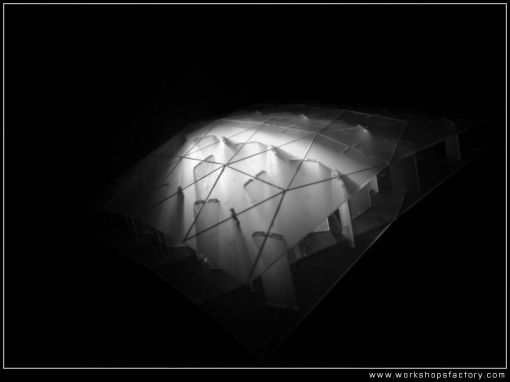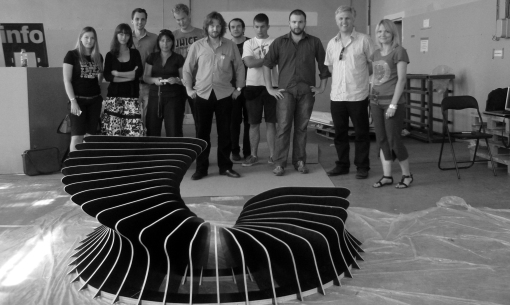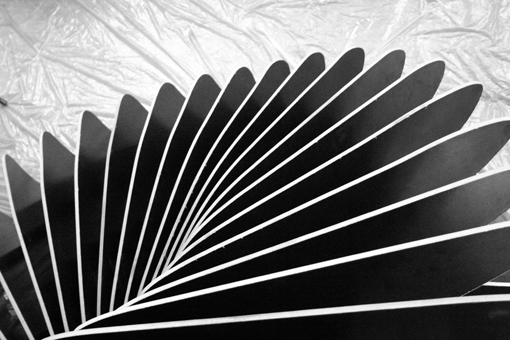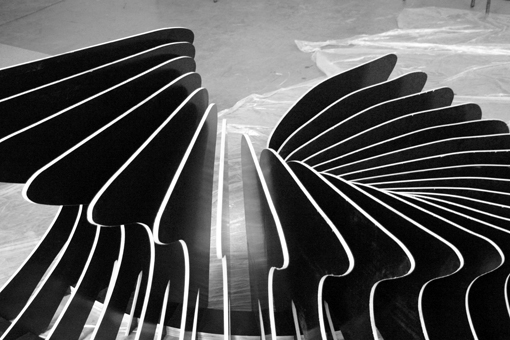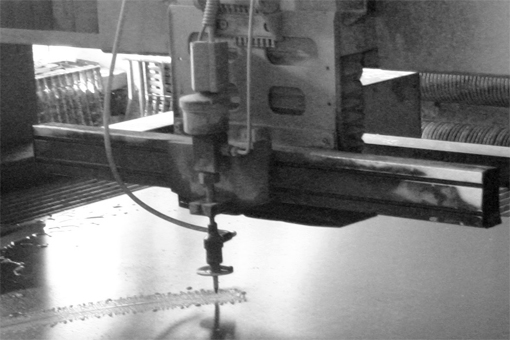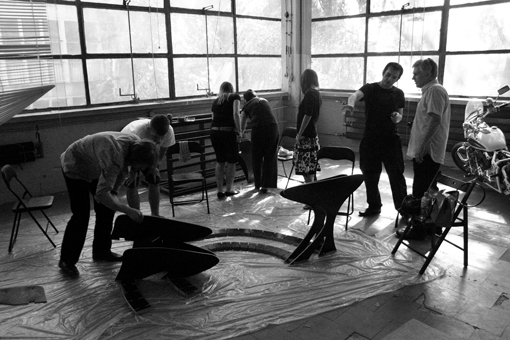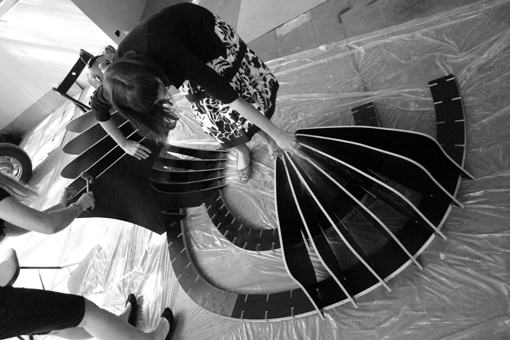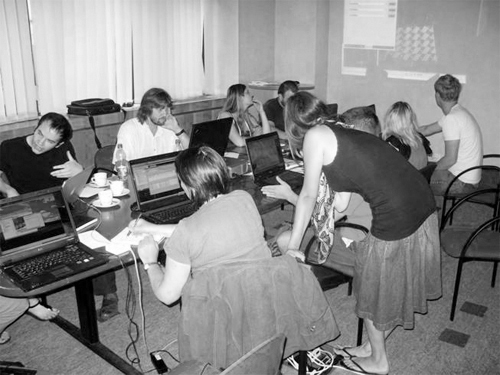This lamp is a second project from ‘Parametric Modeling and CAM Technologies’ seminar which was finally fabricated and assembled. The idea of the design proposal was to create a lamp which starts from two double-curved surfaces. For this reason Generative Components scripts takes two double curved surfaces as an input and transforms them into mesh with special cuttings and joints in between. Final form was laser-cut out of 1mm semi-transparent plexiglass.
The project was done by: M.Brzeski, A. Rokicka, M. Rudnicki, D. Pędrakowski, P. Michalak under tutorship of Workshop Factory.
‘Parametric Modeling and CAM Technologies’ – final project 02
26 02 2010Comments : Leave a Comment »
Categories : 'Parametric Modeling and CAM technologies' seminar, Agata Kycia, digital fabrication, Dorota Kabala, generative components, generative design, Krystian Kwiecinski, Krzysztof Gornicki, laser cutting, Michal Piasecki, parametric design, teaching
‘Parametric Modeling and CAM Technologies’ – final project 01
24 02 2010At the end of February one of the projects done during ‘Parametric Modeling and CAM Technologies’ seminar was finally assembled and installed in the main hall of the building of Warsaw University of Technology (WAPW). It is a result of a fall semester master course seminar at the WAPW, which was tutored by Workshops Factory. Fabricated project was designed by J. Bartos, M.Piotrowska, J. Soltyk and A. Zajkowski.
On the 26th February (Friday) at 12.00 at the Warsaw University of Technology / Architecture Faculty (ul. Koszykowa 55, Warsaw) final review of the seminar and projects exhibition will take place. You are welcome to join if You are around.
Vodpod videos no longer available.Video presents fabrication and assembling process of the project. The overall geometry of the design proposal was designed by using Bentley’s Generative Components, which allows controlling form by a set of parameters.
Comments : Leave a Comment »
Categories : 'Parametric Modeling and CAM technologies' seminar, Agata Kycia, CNC milling, digital fabrication, Dorota Kabala, generative components, generative design, Krystian Kwiecinski, Krzysztof Gornicki, Michal Piasecki, parametric design, teaching
‘Parameteric Modeling and CAM technologies’ – seminar at the Warsaw University of Technology
20 02 2010‘Parametric Modeling and CAM Technologies’ was a seminar run during a master course at the Warsaw University of Technology (WAPW). Its aim was to introduce parametric software and the CNC manufacturing processes to the students. Thus the classes started with the theoretical introduction to computational processes in architecture and Bentley’s Generative Components tutorials. Later on the students were divided into four groups of 3-4 people working separately on their designs. The subject of the studio project was a design of a three dimensional installation in the space of the main staircase at the WAPW building. One of the main objectives of the studio was to fabricate one or two of the installations using a 2-axis milling machine or laser cutter.
GROUP 01 (students: J.Bartos, M. Piotrowska, J.Soltyk, A. Zajkowski)
The idea of the project was to separate certain part of the staircase area from its overall space. Thus the shape of the project starts from a simple rectangle and the gradually offers semi closed space at its lower level. Both global shape of the design and its local components details are parametrically driven by a set of parameters. The project is going to be fabricated (in collaboration with NC.art company) and installed in the main hall of Warsaw University of Technology.
The video presents the process of generating geometry of the project in Bentley’s Genertive Components and the way of controlling specific dimensions by certain parameters.
Vodpod videos no longer available.GROUP 02 (students: B. Cyruchin, M. Strzala, L. Maleszewski, P. Pachowski)
The concept of the design proposal was to design a lamp, which would follow the shape of the handrail, and would be parametrically controlled by the ammount of light it produces. And so the main curve represents the border of the enlighten area, and then the form adjusts to its requirments. Furthermore all the structural parts are parametrically controlled by a set of sliders.
Vodpod videos no longer available.GROUP 03 (students: K. Graczuk, L. Wawrzenczyk, M. Szulc)
The design proposes a parametric wall which can work for different types of exhibition (phtotos, architectural projects, drawings, etc). It is driven by a set of parameters like the overall shape of the wall, possible openings in between, sizes of the modules or thickness of the material.
Vodpod videos no longer available.GROUP 04 (students: A. Rokicka, P. Michalak, M. Brzeski, M. Rudnicki, D. Pedrakowski)
The idea of the project was to create a lamp which starts from two double-curved surfaces. For this reason GC script has been developed as a tool for conversion of two double-curved surfaces in two meshes made of triangles, that are interconnected to ensure stability of construction. Depending on version base geometry may be imported from external file or be generated inside the script. Three different iterations of the project are going to be fabricated in 1:1 scale.
We would like thank to WAPW (Pracownia Projektowania Architektonicznego Wspomaganego Komputerem – Katedra Projektowania Architektonicznego, kierownik katedry: J. Slyk) for their help in organizing the class and to all the students participating in the course for their effort. More information about final results of the seminar will be posted soon.
Comments : Leave a Comment »
Categories : 'Parametric Modeling and CAM technologies' seminar, Agata Kycia, CNC milling, digital fabrication, Dorota Kabala, generative components, generative design, Krystian Kwiecinski, Krzysztof Gornicki, Michal Piasecki, parametric design, teaching
WF_092: 17th – 21st of August in Warsaw
24 08 2009WF_092 was a workshop about parametric modeling and digital fabrication which took place from 17th till 21th of August 2009 in Warsaw. We would kindly like to thank Bentley Systems and sztuka-architektury.pl for their valuable help in organizing it. Our parametric tool was Generative Components and digital fabrication tool was a 2d water jet.
17th of August begun with a general introduction to computational design: from computational forms to the potential of artificial intelligence in design. An introduction to computational design tools such as parametric modeling, scripting and programming followed.We have spent the rest of the day on type-along GC tutorials.
18th of August begun with an introduction to computer aided manufacturing. From then on workshop’s participants worked in teams on parametric designs of urban furniture.
A mock-up of one of the designs was manufactured using water-jet and assembled on the 21st of August.
We would like to thanks to all of the participants for their inspiring and hard work.
Below is a video screen capture of the manufactured model in GC and a couple of images of the final piece:
Vodpod videos no longer available.
Water jet cutter in action:
Assembly of the final piece at the digital manufacturing facility:
Comments : Leave a Comment »
Tags: Bentley Systems, sztuka-architektury.pl
Categories : Agata Kycia, digital fabrication, generative components, Krzysztof Gornicki, Michal Piasecki, parametric design, water jet, WF_092
WF_092 is currently taking place
20 08 2009We are currently tutoring WF_092 – a Generative Components and digital fabrication workshop in Warsaw. It is organized in collaboration with Bentley Systems and sztuka-architektury.pl. The workshop begun on 17th on August. We have spent four days on modeling and scripting in GC at the premises of Bentley Systems’ division in Poland. Tomorrow we are visiting the water jet fabrication facility in order to cut out and assemble urban furniture designed by workshop’s participants
photo: courtesy of Krzysztof Sołoducha
Comments : Leave a Comment »
Tags: Bentley Systems, sztuka-architektury.pl
Categories : Agata Kycia, digital fabrication, generative components, Krzysztof Gornicki, Michal Piasecki, parametric design, WF_092
surface division – an alternative for isoparametric division
22 03 2009On the picture above you can see my attempt to develop new parametric way of surface division as an alternative for often used isoparametric division.
My approach was developed by incorporating scripts into GC, which was done during the design explorers class at the TU Delft under tutorship of Axel Kilian.
The robust division allows for adjusting the density accorging to the size of required elements as well as optimization of their size.
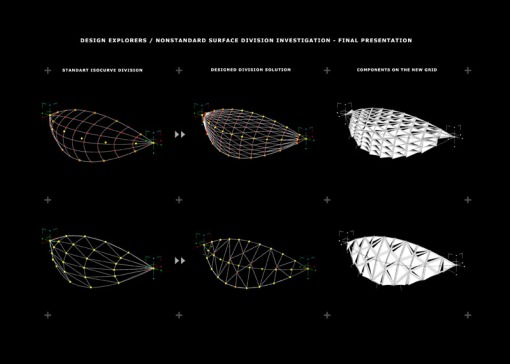
Comments : Leave a Comment »
Tags: generative components
Categories : Agata Kycia, generative components, generative design, parametric design


